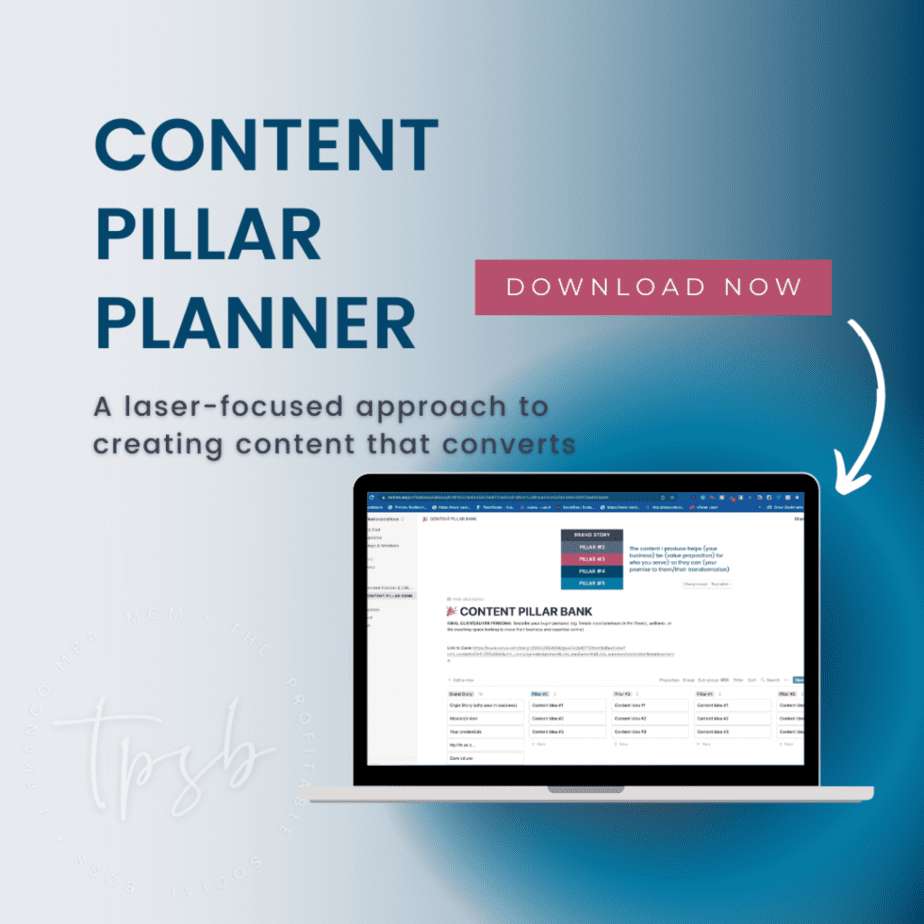Creating content for your business as a solopreneur can be time-consuming, tedious, hard, and even get idea burnout. The answer to this is content pillars.
You’re likely too busy with content ideation, creation, and execution, especially if you’re working alone as a solopreneur. So, how can you maintain consistency and organization in your present plan when time is tight and your social media content ideas are running low?
Two words: content pillars.
In this article, I’ll show you how and why content pillars can help you focus and organize your social media strategy & content. Not only will it make it easier to generate content for your business but it will make you feel confident that your content will convert.
What are content pillars?
A content strategy allows you to optimize your social media marketing for conversion, specifically a content pillar strategy.
Content pillars are the broader topics and themes that create the foundation of your content marketing. This content should also reflect the content that is most popular with your online audience.
Often referred to as content buckets or content clusters, content themes, or categories, pillars consist of the most relevant topics for your industry and target audience. The content pillars that you choose should encompass and be consistent with your brand’s purpose, values, tone of voice, positioning, and general aesthetic look and feel on social media.
Generally speaking, you should select three to five content pillars to consistently create content that will amplify across social media.
Content pillars heavily rely on your niche. Depending on your industry, you’ll have a lot of flexibility in what content pillars will look like. For example, if you’re a wedding photographer or planner, then your content pillars might be product reviews, lead generation for clients and/or new leads, inspiration boards & ideas, new trends in the bridal space.
If you are a non-profit this may include fundraising, your non-profit’s brand story, the organization’s news and community impact, testimonials/success stories, and inspiration (related to your industry the who you serve).
However, a social media marketer’s pillars could look like brand story/authority, Instagram marketing, creating reels, reaching your ideal audience through social, and content marketing.

Why are content pillars important?
Pillars help you to create consistent messaging across the board allowing your audience to have a much clearer picture of who you are, what you stand for, and how they can get in touch with you through social media.
It keeps your content diverse (you’re not stuck posting pictures only you’re saying something new and fresh every time), the more content you create, the better it is for your overall reach.
The more content you post, the greater chance of people engaging with you not just once but many times throughout a given month or year. And that way you can avoid those dreaded social media silences that happen where those who follow your account never see a post again.
It provides consistent value to your audience. You become the authority in those content pillars “aka” topics.
Content pillars also save you time and energy in content creation by organizing all your content topic ideas in one place so it’s easy to create content for each social media platform, depending on what your goals are for that specific platform.
How to create content pillars?
Now that you know why it’s important, here are the key steps for creating high-quality content pillars that your audience will love.
Start by identifying topics in your industry or niche related to what you do. These can be everything from client stories or client testimonials, reels of work, industry news, business trends, new products and/or services you’re offering, or even coaching and online workshops.
Look at your social analytics and determine what content topics are getting the highest engagement rates. Take a look at both long-form and short-form engagements (shares, likes, comments). This can be done with any number of tools including your Facebook Insights (under “posts”) or by exporting your Instagram analytics.
These are the content pillars you want to focus on creating in order of priority. Once you’ve selected the top five, it’s time to brainstorm new ideas that fit within those topics under each pillar.
After you have created a list of ideas for pillars, it’s time to refine them. You can refine these by asking yourself some questions such as:
1) Would I want to see this content? Why or why not?
2) Would my target audience be interested in this topic? Why or why not?
Want all the questions to ask before posting? Download the Message Matrix.
Make sure the topics are authentic and align with what you do. You can’t create content that doesn’t actually flow with the rest of your brand, otherwise, it will feel inauthentic and decrease the know, like, and trust factor with your audience.
Once you have refined these topics, clear out any redundant ideas until you are left with only three to five potential themes. Ready to create your content pillar strategy and the topic bank? Check out my notions template.
Add any other ideas that come up under the pillar to your list of content topics but make sure you prioritize which ones get created first based on their success rate such as engagement, reach, impressions, views &, etc.
Create an editorial calendar to map out when you will post each piece of content. Be mindful of how often you post to each platform as well as how much new content you create during that time.
Finally, it’s important to set realistic and measurable goals on what success looks like for each content pillar and incorporate those into your content strategy and overall marketing plan.
Questions? Feedback? Leave your thoughts in the comments. Also, be sure to check out my “How content pillars can help you plan a year’s worth of content in under 1 HOUR!”

